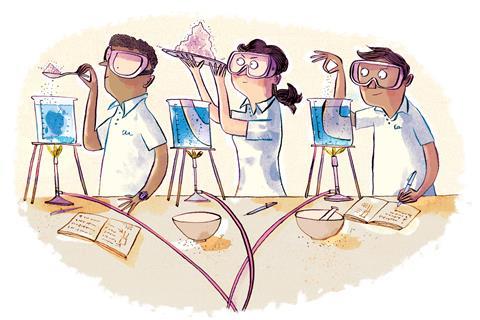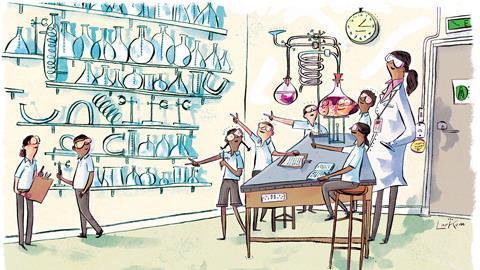Find out how one chemistry teacher successfully adapted her approach to practical work to include student decision-making
I used to conduct all class practicals in a controlled way. I gave groups the same equipment and method, and expected them to get the same results. It’s what I perceived and understood to be a successful practical lesson. I could monitor progress quickly, manage behaviour effectively and predict experimental outcomes. I wasn’t alone in my thinking: developing students’ decision-making in practical science enquiry is an important national curriculum aim for key stage 3 students in England, yet research indicates that many students’ only experience of practical work involves following a set of instructions.
I was sceptical about the idea of student choice. Why would students need a choice to enhance their learning experience when controlled, structured practicals had always worked?
Then I met Lucy. As a lecturer in chemistry education, she was well placed to suggest a different way of doing things. Through our collaborative professional development, we began talking about encouraging students to make decisions in practical work. And while our early discussions prompted me to rethink my approach, I wasn’t confident going into my first less-structured practical and was nervous about not having complete control in my classroom.
A positive change
I was pleasantly surprised by the improved engagement, enthusiasm, motivation and behaviour of students when given some choice, even though the choice was simply picking their salt mass range for a dissolving investigation. This led me to seek more opportunities, gradually extending my students so they were eventually able to design their own method and experimental variables.
I found that choice leads to richer peer dialogue and debate – students had to justify their decisions by linking to experiment variables and methods, rather than just discussing task distribution. Peers shared more scientific language and ideas, and I noticed that students paid more attention to detail when taking measurements – for example, when reading meniscus levels.
My students became better at using a whole range of scientific skills and making informed experimental choices
I introduced the idea of preliminary investigations, and students began realising that making mistakes and modifying methods are part of the experimental process and are not to be feared. We celebrated finding solutions from mistakes. Students became better at identifying anomalies in real time, debating reasons for anomalies through rich student–teacher discussions. They realised they had to repeat the method, celebrating their experimental techniques when they observed a narrow range of values for repeat results. In short, my students became better at using a whole range of scientific skills and making informed experimental choices.
However, it’s important to balance the learning benefits of fostering decision-making with other curriculum demands. Time is my main barrier. Because of this, I plan for more open investigations once or twice a year, providing opportunities for smaller choices in weekly experiments. It’s about finding small but regular opportunities for my students to practise decision-making, so they are ready and equipped to engage in more open investigations when time allows. For example, I used a series of three lessons towards the end of the year for my younger learners to design an investigation on salt solubility, where they chose their independent variable: temperature, volume of solvent or surface area of the salt.
Low effort, high impact
Since working with Lucy, my approach to practical work has changed in a positive way and I’ve started asking myself new questions as I complete my weekly lab requisitions. Is there an opportunity for students to choose their own range for an independent variable? Could students decide on a particular piece of equipment or its size? I find regular run-of-the-mill practicals do allow for decision-making, and I incorporate these into my planning. Now my classes can decide how many coils to wrap around their iron core, choose the size of the measuring cylinder to find the density of irregular objects, and select their ink colour for chromatography. These choices may seem trivial, but the impact on student learning and engagement is great.

Where to begin?
When you start letting learners make decisions, my advice is to limit it to one choice and then increase decision-making as your class progresses. This allows students to become more confident in making decisions, while also understanding how their choices may affect experimental results. I’ve discovered that group size can affect student decision-making – pair work seems to (mostly) work best.
Introduce scientific concepts strategically so each practical develops theoretical understanding, and give students time to revisit and elaborate after data collection. To make marking more time efficient, I may review students’ own results analysis through classroom conversations, but also use a single set of data from exam questions for class graph plotting and written data analysis. This allows for timely and detailed whole-class feedback.
Alongside this, I introduce students to necessary practical skills ahead of experiments so they are competent in handling and using equipment. For example, before choosing the range of temperatures for an experiment, students must be able to read and handle a thermometer correctly. Teacher modelling of new techniques can be invaluable. For example, prior to students making electromagnets, I model an incorrect technique of how to wrap wire around an iron core, questioning how students would fix the error and how this would affect my results. In doing so, I can anticipate potential mistakes before they occur and give whole-class feedback efficiently.
The availability of equipment can hamper decision-making opportunities. It’s vital to have open conversations with teachers and technicians, to ensure equipment choices are possible before completing requisitions. These conversations often lead to alternative solutions, ideas and sharing best practice. Keep equipment simple when giving choice, aiming to use readily-available resources.
Safety comes first
I don’t believe every practical should involve student decision-making. I avoid this for activities involving high temperatures, corrosive substances or where lots of equipment is required. Some practicals do not lend themselves to this approach, as it can be more difficult to pick up on safety issues if each group is doing something slightly different – when investigating the reactivity of different metals in dilute acid, for example. Students must learn how to follow explicit instructions as this is also a key skill they need to master.
For me, student choice is not an all-or-nothing approach. These practicals are interwoven with structured practicals to build up a repertoire of science skills that help develop student creativity, analysis and critical thinking skills.
Since adopting this style of practical teaching, my students now view mistakes, equipment modification and changes to independent variable ranges as part of the experimental process. They know a good practical is not simply about obtaining perfect results in the allocated time. Of course, each class is different, and teachers know their students best, but give it a go – sometimes it’s those you least expect that engage the most!
Resources to help you implement this approach
- Try an investigative approach for a water purification experiment and find more practical problem-solving ideas from our In search of solutions collection.
- Use a step-by-step approach to get your students writing a hypothesis and planning an investigation.
- Link planning to exams with these exam-style questions asking students to spot mistakes.










No comments yet